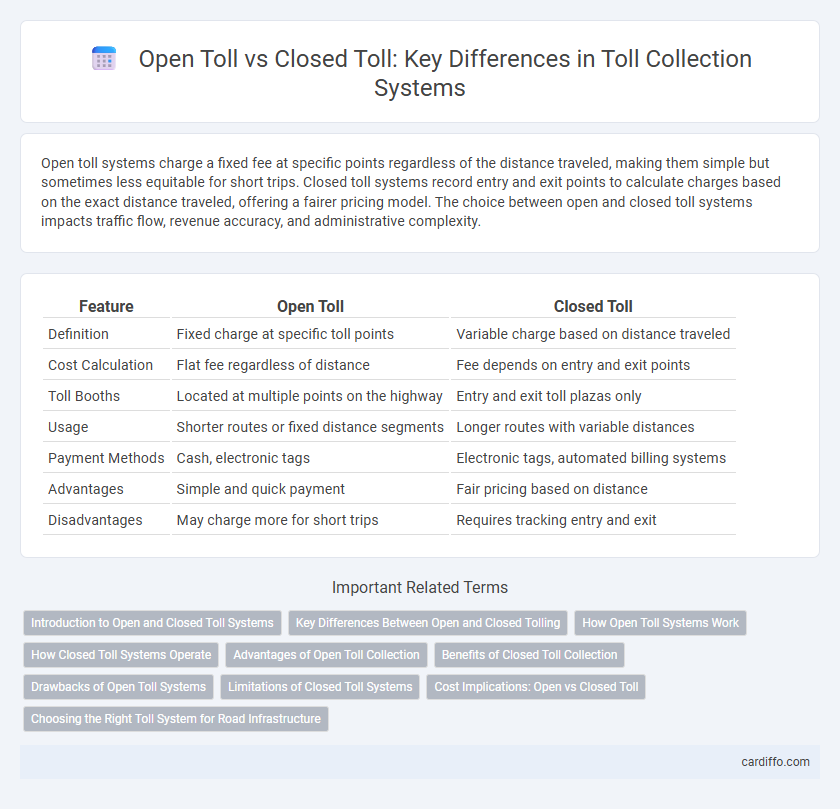Open toll systems charge a fixed fee at specific points regardless of the distance traveled, making them simple but sometimes less equitable for short trips. Closed toll systems record entry and exit points to calculate charges based on the exact distance traveled, offering a fairer pricing model. The choice between open and closed toll systems impacts traffic flow, revenue accuracy, and administrative complexity.
Table of Comparison
| Feature | Open Toll | Closed Toll |
|---|---|---|
| Definition | Fixed charge at specific toll points | Variable charge based on distance traveled |
| Cost Calculation | Flat fee regardless of distance | Fee depends on entry and exit points |
| Toll Booths | Located at multiple points on the highway | Entry and exit toll plazas only |
| Usage | Shorter routes or fixed distance segments | Longer routes with variable distances |
| Payment Methods | Cash, electronic tags | Electronic tags, automated billing systems |
| Advantages | Simple and quick payment | Fair pricing based on distance |
| Disadvantages | May charge more for short trips | Requires tracking entry and exit |
Introduction to Open and Closed Toll Systems
Open toll systems charge vehicles a fixed fee at one or more toll points without tracking distances traveled, making them simpler and faster to manage. Closed toll systems record entry and exit points, calculating tolls based on the exact distance driven between those points, resulting in a more precise fee structure. Each system offers trade-offs in terms of infrastructure complexity, cost accuracy, and traffic flow efficiency.
Key Differences Between Open and Closed Tolling
Open toll systems charge vehicles a fixed fee at specific points regardless of distance traveled, facilitating faster traffic flow but potentially less accurate toll collection. Closed toll systems record entry and exit points, calculating fees based on distance traveled, ensuring fair charges but requiring more infrastructure and longer processing times. The choice between open and closed tolling impacts traffic management, revenue accuracy, and operational complexity.
How Open Toll Systems Work
Open toll systems operate by allowing vehicles to pass through toll points without stopping, using electronic transponders or automatic license plate recognition to record toll payments. These systems rely on strategically placed sensors or cameras, which capture vehicle information as it drives past, enabling seamless toll collection and reducing traffic congestion. Data collected is transmitted to centralized processing centers where toll charges are calculated and billed based on vehicle classification and distance traveled.
How Closed Toll Systems Operate
Closed toll systems operate by issuing a ticket or recording an entry point when a vehicle enters the toll road, tracking the distance traveled to calculate the precise toll fee upon exit. This method ensures tolls are based on actual usage, providing a fair and usage-based charging structure compared to flat rates in open toll systems. Electronic toll collection technologies, such as RFID transponders or license plate recognition, enhance efficiency and reduce congestion in closed toll systems.
Advantages of Open Toll Collection
Open toll collection systems eliminate the need for vehicles to stop at toll booths, significantly reducing traffic congestion and improving travel time efficiency. These systems use electronic sensors and license plate recognition technology, enabling seamless toll payment without interrupting traffic flow. Open toll collection also lowers operational costs by minimizing the infrastructure and staffing requirements compared to closed toll systems.
Benefits of Closed Toll Collection
Closed toll collection systems offer precise toll calculation based on actual distance traveled, ensuring fairer charges for drivers. This method reduces congestion by streamlining the tolling process and minimizing stops, which improves traffic flow and decreases emissions. Enhanced revenue accuracy supports better infrastructure maintenance and funding for transportation projects.
Drawbacks of Open Toll Systems
Open Toll systems often lead to revenue losses due to increased toll evasion and reduce accurate traffic data collection compared to Closed Toll systems. They create congestion at toll points by requiring multiple stops for payments rather than a single entry-exit transaction. The lack of precise distance-based charging in Open Toll systems can also cause unfair toll pricing, resulting in dissatisfaction among road users.
Limitations of Closed Toll Systems
Closed toll systems often face limitations such as higher infrastructure costs due to the need for entry and exit point detection equipment. They require accurate tracking of vehicle entry and exit locations, which can lead to privacy concerns and technical challenges in capturing data consistently. Traffic congestion may increase at toll plazas, causing delays compared to open toll systems that charge a flat rate without stopping vehicles.
Cost Implications: Open vs Closed Toll
Open toll systems typically charge a fixed fee regardless of distance traveled, potentially leading to lower costs for short trips but higher expenses for longer journeys. Closed toll systems calculate fees based on entry and exit points, ensuring users pay proportionally to the distance driven, which often results in fairer toll costs for extended travel. Cost implications vary with travel patterns; drivers making frequent short trips benefit from open tolls, while those covering long distances save more with closed toll mechanisms.
Choosing the Right Toll System for Road Infrastructure
Open toll systems charge drivers a fixed fee regardless of the distance traveled, making them suitable for short stretches or urban areas with high traffic flow. Closed toll systems calculate fees based on entry and exit points, providing a fairer cost distribution for long-distance travel and complex highway networks. Selecting the right toll system depends on factors like road length, traffic patterns, and administrative efficiency to optimize revenue and minimize congestion.
Open Toll vs Closed Toll Infographic

 cardiffo.com
cardiffo.com